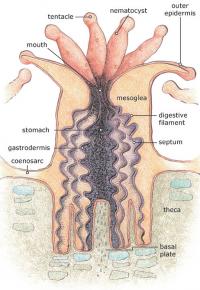Research ProjectCoral Diseases
Project Goal
We examine diseases impacting multiple species of corals across the Caribbean, focusing on the interaction between corals and their microbial symbionts.
Description

While most people recognize corals for their large structure and bright colors, those large structures are actually created by many small coral polyps, which live close together in a tight knit colony. These polyps, which are invertebrate animals (as they lack a backbone), create a hard skeleton, which over time accumulates into the complex 3-D structures that are called coral reefs.
Corals around the globe are plagued by many abiotic (e.g., temperature, pollution) and biotic (e.g., pathogens) stressors, causing incredibly declines. In the Caribbean basin, populations of corals species are impacted by numerous diseases, which are named based on the visible signs of disease such as white band, black band, and stony coral tissue loss disease. Though the actual pathogen (or pathogens) that cause each of these diseases has not been discovered, we know that coral disease results from a change in the interaction between the microbial community and the coral polyps. Thus, our work is examining the ecology and evolution of these interactions and what measures might mitigate disease severity in wild and cultured corals.



